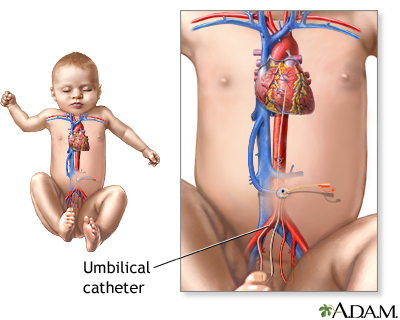Umbilical catheters
UAC; UVC
Images

I Would Like to Learn About:
Information
The placenta is the link between mother and baby during pregnancy. Two arteries and one vein in the umbilical cord carry blood back and forth. If the newborn baby is ill right after birth, a catheter may be placed.
A catheter is a long, soft, hollow tube. An umbilical artery catheter (UAC) allows blood to be taken from an infant at different times, without repeated needle sticks. It can also be used to continuously monitor a baby's blood pressure.
A UAC is most often used if:
- The baby needs breathing help.
- The baby needs blood gases and blood pressure monitored.
- The baby needs strong medicines for blood pressure.
An umbilical venous catheter (UVC) allows fluids and medicines to be given without frequently replacing an intravenous (IV) line.
A UVC may be used if:
- The baby is very premature.
- The baby has bowel problems that prevent feeding.
- The baby needs very strong medicines.
- The baby needs exchange transfusion.
HOW ARE UMBILICAL CATHETERS PLACED?
There are normally two umbilical arteries and one umbilical vein in the umbilical cord. After the umbilical cord is cut off, the health care provider can find these blood vessels. The catheters are placed into the blood vessel, and an x-ray is taken to determine the final position. Once the catheters are in the right position, they are held in place with silk thread. Sometimes, the catheters are taped to the baby's belly area.
WHAT ARE THE RISKS OF UMBILICAL CATHETERS?
Complications include:
- Interruption of the blood flow to an organ (intestines, kidney, liver) or limb (leg or rear end)
- Blood clot along the catheter
- Infection
Blood flow and blood clot problems can be life threatening and require removal of the UAC. The neonatal intensive care unit (NICU) nurses carefully monitor your baby for these possible problems.
References
Del Valle Rolón ME. Procedures. In: Anderson CC, Kapoor S, Mark TE, eds. Harriet Lane Handbook, The: The Johns Hopkins Hospital. 23rd ed. Philadelphia, PA: Elsevier; 2024:chap 4.
Santillanes G, Claudius I. Pediatric vascular access and blood sampling techniques. In: Roberts JR, Custalow CB, Thomsen TW, eds. Roberts and Hedges' Clinical Procedures in Emergency Medicine and Acute Care. 7th ed. Philadelphia, PA: Elsevier; 2019:chap 19.
Whiting CH. Umbilical vessel catheterization. In: Fowler GC, ed. Pfenninger and Fowler's Procedures for Primary Care. 4th ed. Philadelphia, PA: Elsevier; 2020:chap 165.
BACK TO TOPReview Date: 11/6/2023
Reviewed By: Neil K. Kaneshiro, MD, MHA, Clinical Professor of Pediatrics, University of Washington School of Medicine, Seattle, WA. Also reviewed by David C. Dugdale, MD, Medical Director, Brenda Conaway, Editorial Director, and the A.D.A.M. Editorial team.

Health Content Provider
06/01/2025
|
A.D.A.M., Inc. is accredited by URAC, for Health Content Provider (www.urac.org). URAC's accreditation program is an independent audit to verify that A.D.A.M. follows rigorous standards of quality and accountability. A.D.A.M. is among the first to achieve this important distinction for online health information and services. Learn more about A.D.A.M.'s editorial policy, editorial process and privacy policy. A.D.A.M. is also a founding member of Hi-Ethics. This site complied with the HONcode standard for trustworthy health information from 1995 to 2022, after which HON (Health On the Net, a not-for-profit organization that promoted transparent and reliable health information online) was discontinued. |
The information provided herein should not be used during any medical emergency or for the diagnosis or treatment of any medical condition. A licensed medical professional should be consulted for diagnosis and treatment of any and all medical conditions. Links to other sites are provided for information only -- they do not constitute endorsements of those other sites. © 1997- 2024 A.D.A.M., a business unit of Ebix, Inc. Any duplication or distribution of the information contained herein is strictly prohibited.
